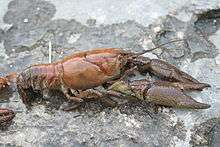Austropotamobius pallipes
Austropotamobius pallipes is an endangered[1] European freshwater crayfish, and the only species of crayfish native to the British Isles.[2] Its common names include white-clawed crayfish and Atlantic stream crayfish.
| White-clawed crayfish | |
|---|---|
 | |
| Scientific classification | |
| Kingdom: | Animalia |
| Phylum: | Arthropoda |
| Subphylum: | Crustacea |
| Class: | Malacostraca |
| Order: | Decapoda |
| Family: | Astacidae |
| Genus: | Austropotamobius |
| Species: | A. pallipes |
| Binomial name | |
| Austropotamobius pallipes (Lereboullet, 1858) | |
Distribution and ecology
It is found from the Balkan Peninsula to Spain and reaches its northerly limit in Great Britain and Ireland, where it also has its greatest population density. A. pallipes is the only species of crayfish found in Ireland, occurring over limestone areas inhabiting rivers, streams, canals, and lakes. It is absent from the more acidic waters of the west,[3] and occurs in streams with a moderate flow alongside other freshwater invertebrates such as caddis fly, mayfly, and mollusc species. Trout and three-spined stickleback also occur in the same habitat. Tree roots and rocks in the banks provide shelter. Juveniles shelter in vegetation such as watercress and grass mats growing out of the bank.
Description
A. pallipes is an olive-brown colour, with pale-coloured undersides to the claws (whence the specific epithet pallipes, meaning "pale-footed"). It may grow to 12 centimetres (4.7 in) long, although sizes below 10 centimetres (3.9 in) are more common. It typically lives in rivers and streams about 1 metre deep, where it hides among rocks and submerged logs, emerging to forage for food, and also in lakes.
Conservation
In France A. pallipes is found in streams such as the Mornante and Sellon, two small tributaries of the Dorlay in the Loire department. It is protected as a heritage species.[4] The distribution of A. pallipes is rapidly shrinking and in Great Britain it is now more or less restricted to central and northern England, east Kent, and eastern Wales and a population has been discovered in Essex.[5] There is also a population in Candover Brook, a tributary of the River Itchen in Hampshire.[6] Until recently a population had existed in the River Frome in Bristol/South Gloucestershire, but Avon Wildlife Trust believe this was wiped out during 2007–2008.[7] Populations of A. pallipes can also be found in the upper reaches of the River Thames, where it competes with the introduced noble crayfish. Dowdeswell Reservoir in Gloucestershire supports A. pallipes and during the engineering works undertaken in 1998, Severn Trent put in place a management programme for its protection.[8] However, it was once found across most of England and Wales.
One of the major reasons for this decline is the introduction of the invasive North American signal crayfish (Pacifastacus leniusculus) and red swamp crayfish (Procambarus clarkii).[9] The signal crayfish is a carrier of crayfish plague, an infectious disease to which it has resistance, while A. pallipes has none. A. pallipes is also sensitive to many kinds of pollution, such as insecticides.
Further reading
Sweeney, N. and Sweeney, P. 2017. Expansion of the White-clawed Crayfish (Austropotamobius pallipes (Lereboullet)) population in Munster Blackwater. Irish Naturalists' Journal. 35(2) pp. 94-98.
References
- L. Füreder; Gherardi, F.; Holdich, D.; Reynolds, J.; Sibley, P.; Souty-Grosset, C. (2010). "Austropotamobius pallipes". The IUCN Red List of Threatened Species. 2010: e.T2430A9438817. doi:10.2305/IUCN.UK.2010-3.RLTS.T2430A9438817.en.
- "Freshwater white-clawed crayfish (Austropotamobius pallipes)". ARKive.org. Archived from the original on 24 January 2015. Retrieved 28 January 2015.
- Catherine Souty-Grosset; David M. Holdich; Pierre Y. Noel; Julian D. Reynolds; Patrick Haffner (2006). Atlas of Crayfish in Europe. Collection Patrimoines Naturelles 64. Paris: Muséum national d'histoire naturelle. p. 188. ISBN 978-2-85653-579-0.
- CESAME (March 2010). "Prélèvements et gestion quantitative de la ressource sur le bassin versant du Gier Phase 1" (PDF). Saint-Etienne Metropole. p. 6. Archived from the original (PDF) on 4 March 2016. Retrieved 20 August 2012.CS1 maint: ref=harv (link)
- "Endangered crayfish colony found". BBC News. 19 September 2006. Retrieved 18 December 2019.
- Stephanie Peay (2003). Monitoring the white-clawed crayfish Austropotamobius pallipes. English Nature. ISBN 978-1-85716-727-6.
- Gray, Louise (21 July 2009). "Crayfish breeding programme to save native species from American invader". The Daily Telegraph. Retrieved 18 December 2019.
- ‘Conservation of the native crayfish population at Dowdeswell Reservoir during engineering works’, March 1998, for Severn Trent Water.
- Manenti, R.; Ghia, D.; Fea, G.; Ficetola, GF; Padoa-Schioppa, E.; Canedoli, C. (2019). "Causes and consequences of crayfish extinction: Stream connectivity, habitat changes, alien species and ecosystem services". Freshwater Biology. 64 (2): 284–293. doi:10.1111/fwb.13215.
External links


- "UK Crayfish Website". Buglife – The Invertebrate Conservation Trust.
